
Welcome to Leader in Water- & Wastewater Solution
Welcome to Leader in Water- & Wastewater Solution
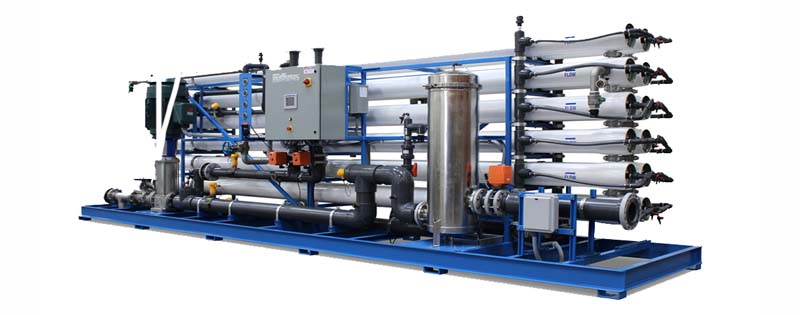
Reverse osmosis (R/O) is a water treatment process in which water is forced through a semi-permeable membrane that has very small holes or “pores”. Clean water passes through and impurities that are too big to pass through the membrane are left behind and flushed away.
It is presumed in this document that the water you are using meets all health regulations and is known to be safe. If your municipality or utility supplies your drinking water, it is likely that you do not need a reverse osmosis unit. Municipally supplied drinking water is micro biologically safe. It is treated to meet health and aesthetic requirements, and is subject to routine testing for microbiological contamination. If you obtain drinking water from a private supply such as well, it may not be safe from microbiological, chemical, or other types of contamination. Drinking water from private sources should be tested periodically to determine if treatment is required; and, if so, for what specific contaminants or minerals. Water chemistry is complex and no single water treatment device can be used to remove all types of substances from water. Different drinking water treatment devices have their own advantages and disadvantages. Each household must individually determine if there is a need for additional water treatment. If this is the case, determine the unit or combination of units best suited for your water needs.
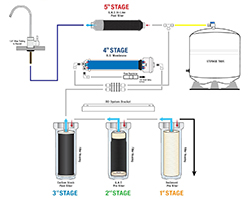
Reverse osmosis systems purify water by forcing pressurized water through a very fine, plastic membrane. If the raw water being treated comes from a well or another private source, disinfection and pre-filters (to remove chlorine and/or particulates/sediment) may be needed in advance of the R/O unit to remove contaminants that can foul or damage the membrane.
During the initial filtration stage, tap water or well water (pressurized by a booster pump) is passed through a particle filter (a pre-filter) that removes silt, sediment, sand, and clay particles that might clog the R/O membrane. The water is then forced through an activated carbon filter that traps minerals and contaminants such as chromium, mercury, copper, chloramine and pesticides. It also removes chlorine, which is important, as chlorine will shorten the life of the membrane.
Water is transferred under pressure into the R/O module, allowing only clean water to pass through the small pores in the membrane. Impurities unable to pass through the membrane are left behind and flushed down the drain. Treated water is then sent to a storage tank. Treated water is passed through an
activated carbon filter before use to further improve the water’s taste and smell. Water that contains manganese, hydrogen sulphide or iron should be pre-treated to extend the life of the membrane. A dealer can recommend the pre-treatment needed.
Note: Reverse Osmosis units produce no noise other than the sound of water discharging into the drain (usually a sink or a floor drain).
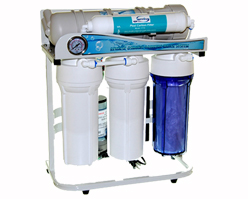
R/O units are rated according to the amount of treated water produced per day. For example, one type of unit produces 50 liters of treated water per day under its design conditions. Such a unit is generally rated with 60 psi water line pressure, a water temperature of 25° C (77° F), normal dissolved solids and 2 atmospheres of pressure.
In reality, conditions frequently vary. Line pressure is often lower, water will frequently be colder than 25° C and back pressure in the storage tank will likely reduce the performance of the unit. Consequently, you should examine water conditions and buy a larger rated unit than needed if any of the above problems are noted.
Reverse osmosis units are sold at some department and hardware stores, and by water equipment dealers. Companies can be found listed under “Water”or “Water Companies” in the Yellow Pages. You may wish to talk to a variety of vendors to compare features.
Reverse osmosis unit prices vary, from $400 for a portable or under sink unit to $2,500 for a larger, stationary (basement) unit where a booster pump and a pressure system are installed. Replacement pre-filters range in price from approximately $100 – $200 each.
Many R/O units are designed to operate on the kitchen counter. Some of the larger units are connected under the counter or in the basement. The unit will need to be hooked up to the water line and a discharge-to-the-drain line. Larger units may require professional installation, where a special water supply line is run from the main household water line. If you are unsure about installation, contact a plumber or mechanical contractor.
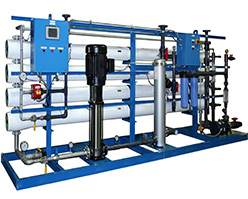
Reverse osmosis can remove dissolved solids, salts, minerals that cause hardness, organic chemicals and other impurities. It can improve the taste of water for people who do not like the taste of dissolved mineral solids.
Treated water will not produce scale in kettles and coffee makers. Because sodium and potassium are removed, people on a medically prescribed sodium- or potassium-restricted diet may benefit. R/O units may also remove contaminants such as chromium, mercury and nitrates. Before purchasing a R/O unit, check the certification and literature for the particular model to verify exactly what it can and cannot remove.
Reverse osmosis treatment systems remove minerals like calcium and magnesium from drinking water. In Canada, water is a minor source of such minerals when compared to foods. If you consume a reasonably balanced diet, you do not need to take a mineral supplement when drinking water treated with a reverse osmosis system. Low levels of minerals in drinking water may be a concern for people living in countries with very hot climates.
A R/O unit should be used only with drinking water that is known to be safe to drink. Although reverse osmosis can remove microbiological contaminants, R/O does not disinfect the water to drinking standards. A flaw or tear to the membrane could allow untreated water to flow through the unit without removing disease-causing organisms. Remember if you are unsure of the quality of your water, get it tested. If you have any doubts about the safety of your water, then it should be disinfected before using a R/O unit.
Some R/O units can produce 4 liters per minute and others will produce 30 to 94 liters per day. In operating a R/O unit, a large amount of incoming water is used to produce the final treated water. This unusable water (called brine) contains contaminants that the R/O unit has removed. The amount of brine created will depend on the quality of the incoming water. Operating a reverse osmosis unit is not water-efficient — and the amount of water used depends on the quality of the incoming water. In some cases, where water is free of dissolved solids, two liters of water may be needed to produce one liter of finished water. In other cases, 4 or 5 liters of water may be used to produce one liter of treated water. A family of four might need 40 to 80 liters of water to produce 8 to 16 liters of treated water for drinking and cooking per day. This would cost about ten to twenty cents per day for water. If more treated water is desired, then more water would be used. This will also increase water and wastewater bills, or create a higher demand on your well and septic system.
Reverse osmosis units must be maintained as per the manufacturer’s recommendations. Typically the sediment pre-filter and the activated carbon pre-filters should be changed at least annually. However, these pre-filters may need to be changed as often as once every six months if the water entering the unit contains sand, large amounts of chlorine or other substances that impair filter efficiency. Although membranes in a well-maintained unit can last for several years, the membrane may need to be replaced more frequently than the manufacturers suggested timeline.
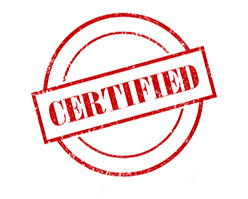
Although drinking water materials such as water filters are not currently regulated in Canada, Health Canada recommends that all products that come into contact with drinking water be certified to the appropriate health-based performance standard developed by NSF International. In the case of Reverse Osmosis, it is recommended that they be certified as meeting standard NSF/ANSI 58.
In Canada, CSA International, NSF International, and Underwriters Laboratories have been accredited by the Standards Council of Canada to certify drinking water materials as meeting the above-mentioned standards. These standards are widely accepted in North America, as they ensure the removal of specific contaminants, as well as the performance and mechanical integrity of the materials that come into contact with drinking water. Check the Reverse Osmosis unit’s packaging or ask your dealer for a listing of the substances that the unit is certified to remove.
You can consult Health Canada’s Web site at http://www.hc-sc.gc.ca/ewh-semt/water-eau/index_e.html, which describes many activities related to Canadian drinking water quality. You can also check the Web site of NSF International at http://www.nsf.org for information about health-based performance standards related to drinking water treatment units. The NSF also provides a listing of systems that it has certified at http://www.nsf.com. The Web site of the Canadian Water Quality Association at http://www.cwqa.com is also an industry source of information for drinking water treatment units. Your local municipality or utility may also have additional information. Canada Mortgage and Housing Corporation acknowledges the contribution of Health Canada to the development of this document.